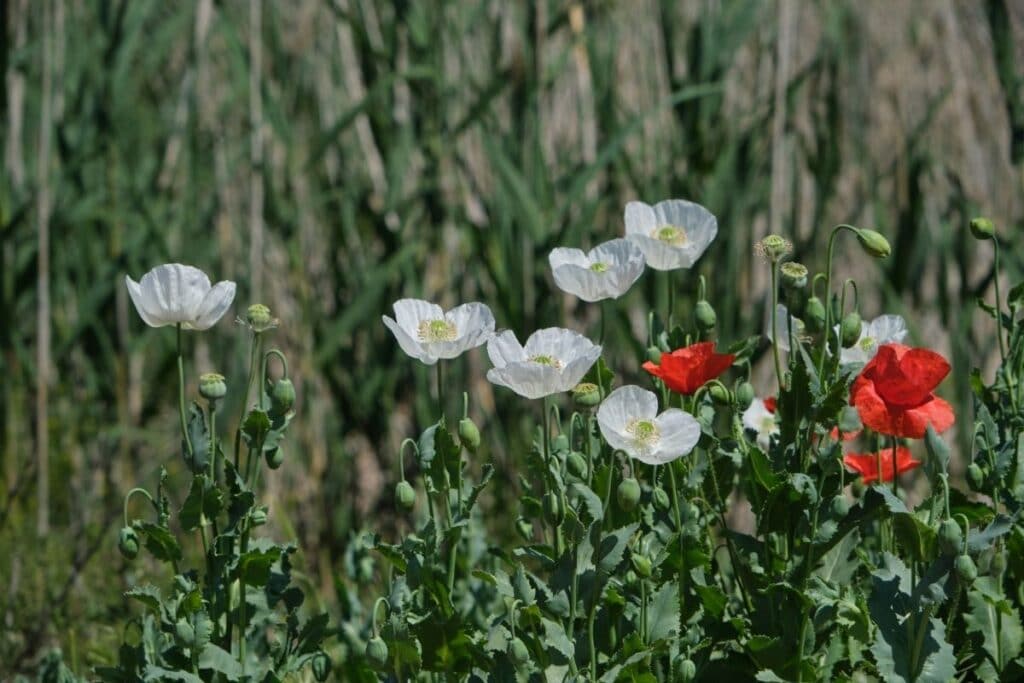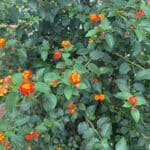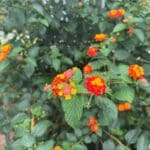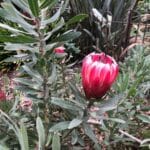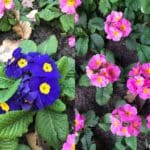Poppy flowers are famous due to their crepe-paper-like blossoms that come in bright and warm colors alike. Growing poppies is relatively easy, as it can self-sow yearly, making it an ideal plant for new gardeners.
Here is everything there is to know about how to grow poppy plants outdoors and why you need to have them in the garden.
Basic Information About Poppy Flowers
- When talking about Poppy flowers, one refers to at least 12 different genera that belong to the Papaveraceae plant family.
- Poppy flowers can be considered a perennial, annual, or biennial plant.
- The narcotic drug opium poppy comes from one particular species, which is the Papaver somniferum. This poppy plant has been used as an analgesic (1) but also as a recreational drug. The most common type of drug that derives from the P. somniferum is morphine.
- Poppies are also known for their meaning. All poppy plants have become an international symbol of remembrance for the falling soldiers during wartime.
- Poppies can grow up to 20 feet tall, and some species are considered to be monocarpic. This means they die soon after flowering.
- A poppy plant is intertwined with history, international travels, and diverse cultures, as it has been transported from across continents for hundreds, if not thousands of years.
- Poppy flowers can be red, orange, golden, yellow, blue, purple, and ivory.
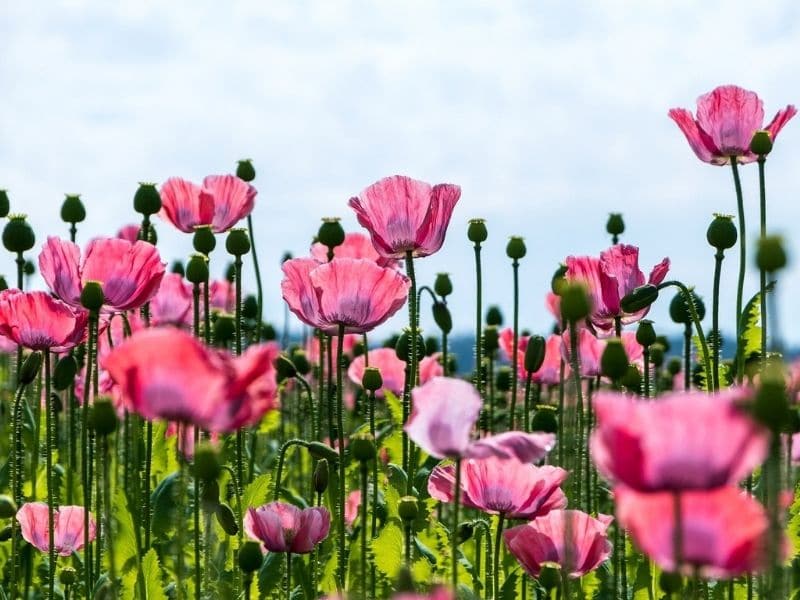
How To Grow Poppies Outdoors
There are many types of flowers you can grow in your garden. Growing poppy flowers outdoors is relatively easy. You need to plant poppy seeds in a sunny location or divide the roots from established poppy plants. However, this plant won’t tolerate being transplanted to the soil due to its taproot. If this taproot is disturbed, then chances are its flowers won’t bloom.
Ideally, poppies should be divided in early fall. This way, the taproots will have enough time to restore themselves before winter sets in. Here are some important poppy care tips:
Soil Requirements
Most poppies belonging to the Papaveraceae subfamily are not very fuzzy when it comes to their soil needs. Poppies need loose soil, albeit in some areas they will even grow in clay soil!
Sun Exposure
If growing poppies indoors, then they need to be fully exposed to direct sunlight. On the contrary, when growing poppy flowers outdoors, they will need to be placed under a partial shade.
Water Needs
When a poppy flower grows outdoors, it needs to be watered constantly and thoroughly. It also prefers well-drained soils.

How to Plant Poppies from Seeds
Ideally, whenever you are growing poppies from seeds, the plants should be sown outdoors in late fall or early winter if the climate is not too cold.
The plant will go through an adaptation period before it begins to germinate. But, once it does, poppies will usually grow healthily.
Be careful with the seeds when growing poppy flowers outdoors, as they are tiny. Just sprinkle the soil’s surface without pushing them downwards. It would be best to separate the longest and strongest seedlings at the beginning of early spring once the plants begin to sprout.
Remember to water the seedlings thoroughly and constantly, but avoid overwatering them. It is advisable to dead-head the poppy plant to prevent it from becoming an invasive species in the garden bed.
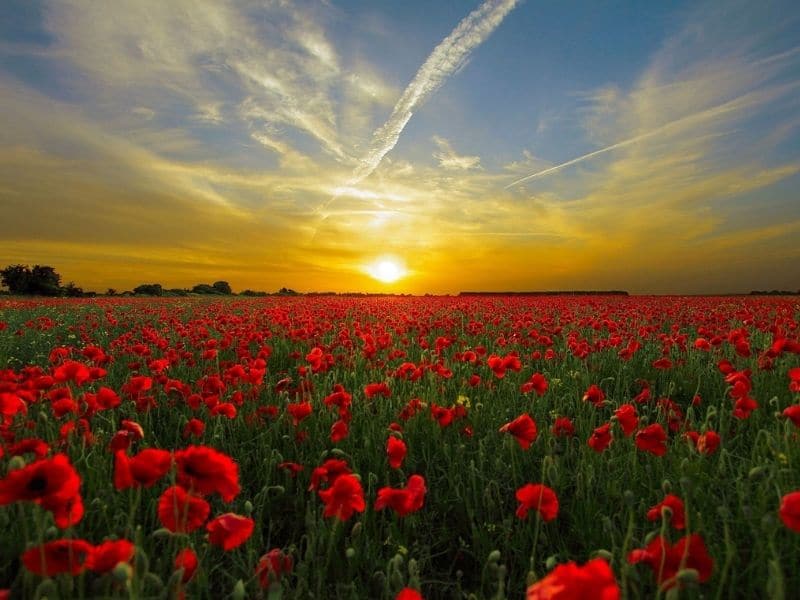
Common Varieties of Poppies
Annual poppies could be from the Papaver or Eschscholzia subgenre, and perennial poppies could be from the Stylophorum subfamily. Lastly, there could also be another genus, which is the Meconopsis.
Papaver Varieties
Alpine
Known as the Papaver alpinum, this dwarf variety can grow up to 1 foot in height. It is a short-lived perennial poppy plant, and it produces red, yellow, white, and orange flowers.
At least four subtypes of alpine poppy flowers can be found in Europe, more specifically in Austria. Additionally, it can grow in the USDA growing zones 4 to 6.
Arctic
This poppy plant is scientifically known as Papaver radicatum. This is another dwarf variety. Its flowers are usually yellow, although there are some pink and white types as well.
All poppy plants prefer rocky soils and full, direct sun. It’s one of the rarest poppy plants thanks to its weather resistance, as it can grow in the arctic zones, which is an area where few plants can thrive. According to the USDA, this variety can grow in areas 2 to 6.
Ladybird
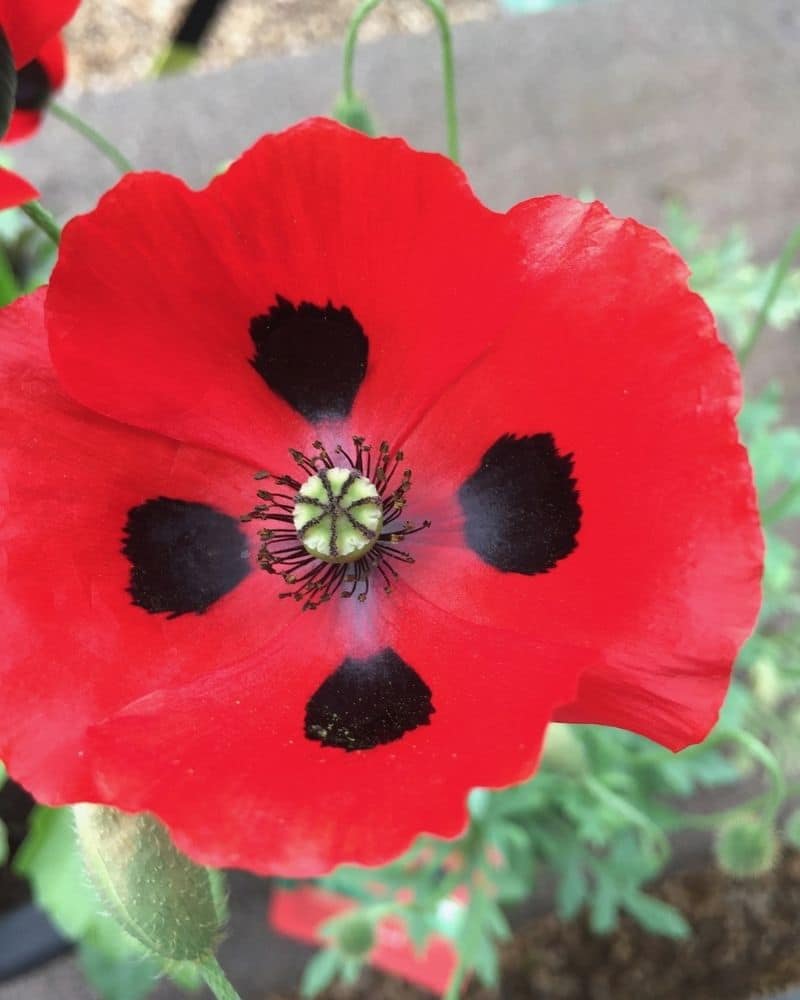
Also referred to as Papaver commutatum, this small variety has bowl-shaped blooms, red or scarlet, making it very similar to the Flanders variety. It will thrive in USDA zones 5 to 8.
Breadseed
Often referred to by its scientific name, Papaver somniferum. It has pink, red, or purple flowers, and it can grow up to 4 feet in height. As its name suggests, these breadseed poppies offer edible seeds often used to adorn bagels, cakes, or muffins, making them an exciting ingredient in the baking world.
Its blooms can be mauve, white, lilac, pink, light orange, or red. However, this is also the poppy plant where opium can be obtained. As a result, it could be troublesome to grow opium poppies in the garden.
Carnation
Scientifically known as Papaver laciniatum. Most gardeners often used it as an ornamental flower because it looks great in vases, thanks to the blooms’ particular shape and length.
Although, if left untouched, it can quickly grow up to 4 feet in height.
This poppy flower is known for its petals’ texture because it resembles feathers. Carnation poppies can grow in USDA zones 3 to 8.
Peony
Scientifically known as Papaver paeoniflorin. As its name suggests, this variety resembles peony blooms. This type has big seed pods, and it can grow up to 3 feet in height. It grows in zones 3 to 8.
Flanders
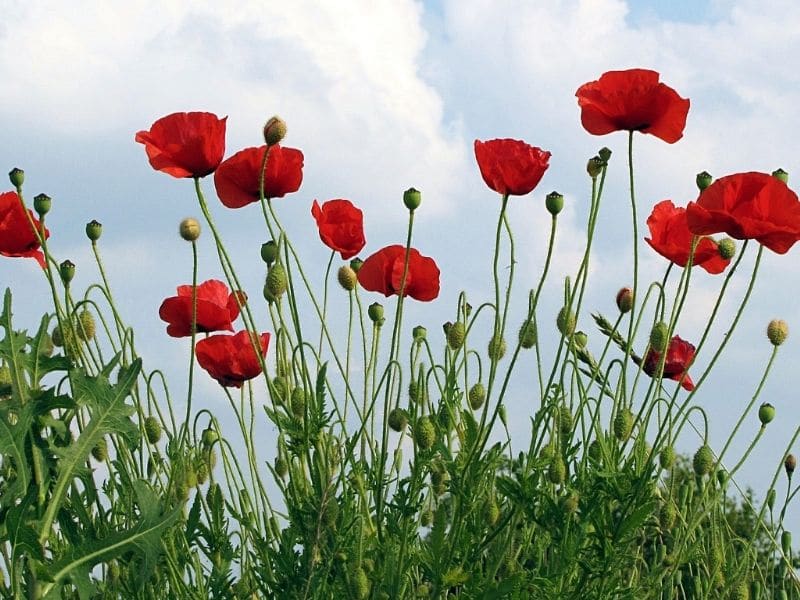
Scientifically known as Papaver rhoeas and colloquially known as corn poppy, field poppy or Common poppy, this variety is used to be considered an invasive species, although nowadays, it is the flower that is used to recognize the fallen soldiers of wars, specifically World War I.
The P. rhoeas variety will bloom throughout April and June, and its blooms are red. Corn poppies are easy to plant, as they will continuously self-seed. It will usually reach 18 inches in height.
Iceland
Papaver nudicaule is its scientific name. These iceland poppies can withstand cold temperatures, albeit only for a short period.
Depending on the location, the P. nudicaule plant will self-sow. Its blooms could be gold, pink, white, or peach, and is often considered a dwarf variety. It prefers USDA zones 2 to 7.
Oriental
These oriental poppies are scientifically referred to as Papaver orientale. It has striking flowers due to its blooms’ dark centers and the contrast it has with the rest of the blooms.
Although P. orientale is a perennial poppy, it will only live for a short period. Its taproots will spread out, which means the plant self-propagates quickly.
Spanish Poppy
Also referred to as Papaver rupifragum, this variety offers bright orange flowers, albeit later, as this variety is a late bloomer.
This plant has double flowers that could reach up to 2 feet in height. According to the USDA, these poppies thrive best in zones 6 to 10.
Eschscholzia Variety
California Poppy
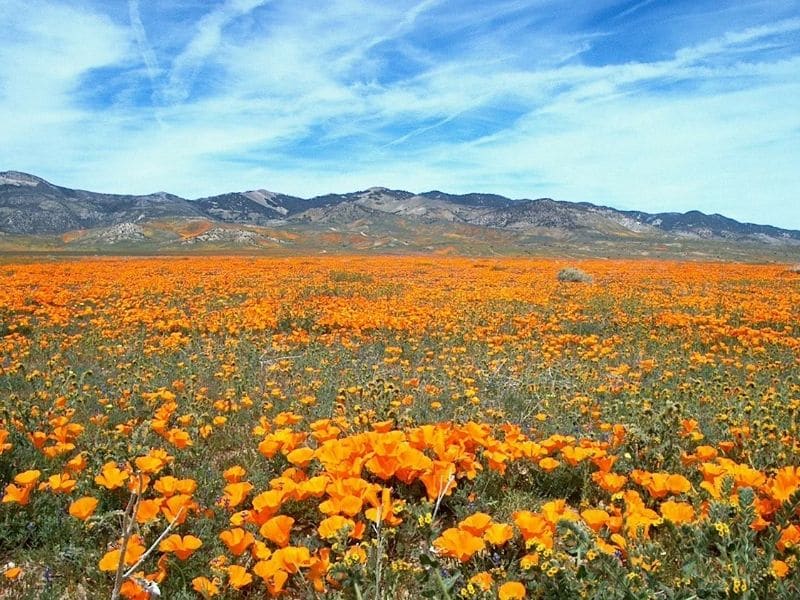
It is scientifically referred to as Eschscholzia californica. Undoubtedly, this poppy variety is one of the most famous ones.
It can be easily found on roadsides across the southern states of the U.S. These california poppies can reach 18 inches in height. Its blooms can be red, orange, or bright pink.
Meconopsis Varieties
Himalayan Blue
This poppy plant is scientifically known as Meconopsis baileyi or Meconopsis betonicifolia. This variety is known for its intense blue blooms that create a vibrant display of color in any garden.
Also known for its self-seeding nature. When this poppy grows outdoors, it prefers moist and cool climates and partially shaded areas. It is regarded as a medicinal herb in many areas of the world (2).
Cambrica
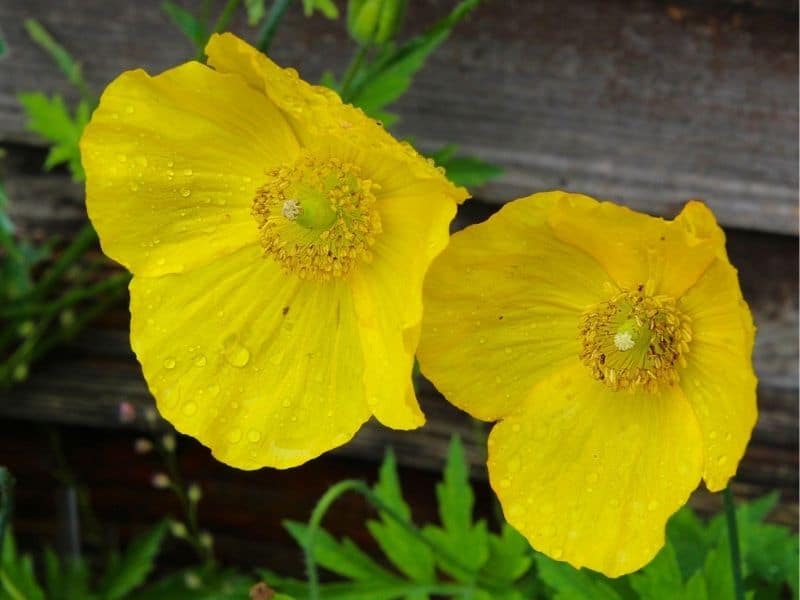
Colloquially referred to as Welsh poppy, this plant is endemic to Europe, where it thrives in damp, cold areas. It has orange and yellow blooms. This poppy flower grows well in zones 6 to 8.
FAQs
Do poppies grow best in sun or shade?
Poppies generally prefer full sun to partial shade. They thrive in sunny locations with well-drained soil, although they can tolerate some shade, especially in hotter climates.
Are poppies hard to grow?
While poppies are relatively easy to grow from seed, they have specific requirements for optimal growth, including well-drained soil, sufficient sunlight, and moderate watering. With proper care, poppies can thrive in gardens and landscapes.
What is the lifespan of a poppy flower?
The lifespan of a poppy flower varies depending on the species and growing conditions. Generally, individual poppy flowers bloom for a few days to a week before fading and dropping their petals.
Do poppy flowers last long?
Poppy flowers have a relatively short lifespan compared to some other perennial flowers. Individual blooms typically last for several days to a week, but poppy plants often produce multiple flowers over an extended blooming period.
Do poppy flowers grow back?
Many poppy species are annuals or short-lived perennials that self-seed readily, allowing new plants to grow from dropped seeds.
Conclusion
Growing poppy flowers outdoors is now a new trend as gardeners are welcoming this flower into their gardens. Not only are poppy flowers known for being drought tolerant, but they are relatively easy to maintain.
Additionally, whenever you grow poppy plants outdoors, they will welcome many beneficial pollinators, such as hummingbirds and honey bees, to the garden. These flowers are known for their simplistic beauty, but they also carry a particular connotation in history, making them a fascinating plant to cultivate.
Up next: Poppy Flower Meaning and Symbolism
References
Reference List:
- Presley CC, Lindsley CW. DARK Classics in Chemical Neuroscience: Opium, a Historical Perspective. ACS Chem Neurosci. 2018 Oct 17;9(10):2503-2518. DOI: 10.1021/acschemneuro.8b00459. Epub 2018 Oct 8. PMID: 30247870.
- Dan Q, Li Q, Li X, Suonan R, Dongzhi D, Guo X. Characterization of the complete chloroplast genome of the prickly blue poppy Meconopsis horridula Hook. f. & Thomson (Ranunculales: Papaveraceae). Mitochondrial DNA B Resour. 2021 Mar 11;6(3):792-793. DOI: 10.1080/23802359.2021.1882902. PMID: 33763580; PMCID: PMC7954420.
- Bozan G, Ulukapi HB, Oncul U, Levent S, Dinleyici EC. A Fatal Case of Opioid Intoxication After Raw Poppy Plant Ingestion. Cureus. 2021 Feb 6;13(2):e13176. DOI: 10.7759/cureus.13176. PMID: 33717721; PMCID: PMC7939539.
Close
*image by jessicahyde/depositphotos

